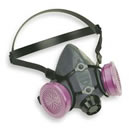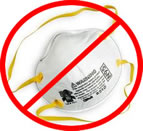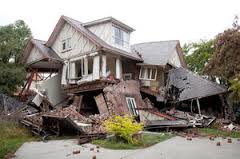 How often have you heard of earthquake preparedness kits on the news as gentle reminders we live in an active area of seismic activity? These reminders often stress the need for extra food, water and basic supplies to help us survive a few days if the big one hits. Given that widespread structural failures may contribute to the disturbance of hazardous materials having some basic personal protective equipment is also important.
How often have you heard of earthquake preparedness kits on the news as gentle reminders we live in an active area of seismic activity? These reminders often stress the need for extra food, water and basic supplies to help us survive a few days if the big one hits. Given that widespread structural failures may contribute to the disturbance of hazardous materials having some basic personal protective equipment is also important.

A paper dust-mask does not provide useful protection from asbestos fibers.
Your home or dwelling may not even be constructed in an era (up to 1990) where asbestos containing materials were commonly used but given the magnitude and scale of destruction entire neighborhoods may be contaminated with hazardous materials. Large quantities of asbestos can be released during and after natural disasters.
Homeowners of damaged properties also face these risks and should always use caution when cleaning or searching through debris.
Asbestos.com outlines the risk of exposure when it comes to fires, floods, earthquakes, hurricanes and tornadoes. To protect yourself, keep all asbestos related debris wet and covered to minimize dust, and always wear additional protective gear, such as boots, coveralls, and gloves during removal. Double-bag all building debris. Enclose the work-area with plastic sheeting and duct-tape to minimize dust. Only disturb construction materials that must be removed and minimize any excess breakage to prevent the release of dust and fibers into the air.
Asbestos is one of the most heat-resistant substances known to man, yet it can be highly toxic when it is confronted by fire.
Be sure to thoroughly shower and wash if you have been involved in debris removal to remove any dust and fibers that could become airborne. The government of New Zealand breaks the risk down into categories and recommends safe practices to prevent exposure. They recommend treating rubble as containing asbestos if in doubt and wearing appropriate personal protective equipment.
Thousands of homes contained asbestos, and owners were often unaware that the material was present and the health risks from exposure to the airborne fiber. – NZ Earthquake
During a disaster, stores of hazardous substances can spill and mix together. Water may seep into storage areas, causing damage to packages of pesticides or harmful poisons.
 Asbestos in Earthquake Cleanup
Asbestos in Earthquake Cleanup
Generally during cleanup of damaged and destroyed buildings after an earthquake, it is likely that there will be a need to handle, break up and dispose of asbestos-containing building and insulation materials. Much of this work may be undertaken by temporary laborers, volunteers and local residents who are unaware of the hazards of asbestos and who may be unable to identify asbestos-containing material.
Natural disasters like floods, cyclones and forest fires can cause major damage to property – this is particularly concerning when there is asbestos-containing materials in the property which is damaged causing release of asbestos fibres.
The safe removal and disposal of asbestos from a damaged property is critical. Contacting your local council and provincial emergency services is a good place to start if faced with building damage from a fire, flood or other natural disaster.



